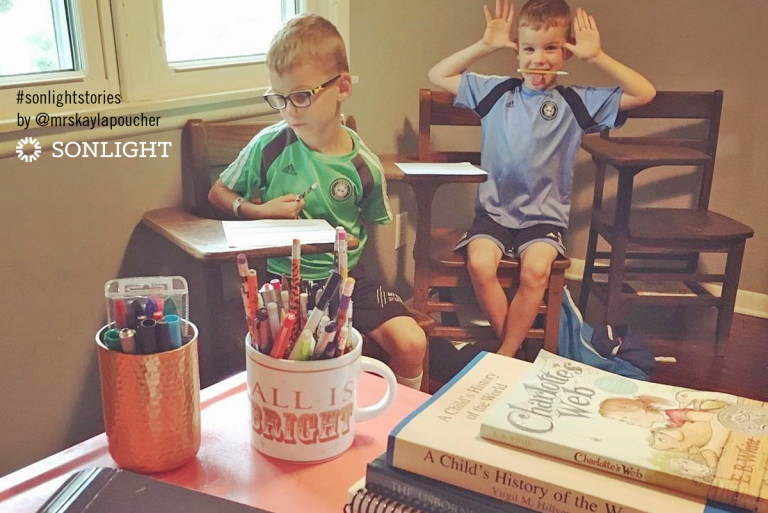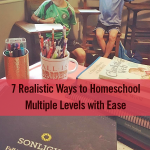
I’ll be honest. One reason I love Sonlight is because I can use a single program, branching off as necessary to match the various ability levels of my kids. However, this year, I really wanted my younger children to go through History / Bible / Literature (HBL) Level B (because every child needs Intro to World History, 1 of 2 in their life!) while my older children needed and wanted to stay on course and move on to Sonlight HBL F for ages 10-13.
So here I am, back once again in the land of multiple children covering multiple Sonlight Levels. It’s okay though. I’m not new to the concept. Today, as I am doing my summer planning for next year, I’m reviewing my best strategies for teaching multiple children in different levels. These aren't pie in the sky tips. These are realistic methods that have worked for me in the past and that I'll be implementing again for a fresh season of homeschooling.
Continue reading below or listen here:
1. Divide Time into Blocks
This is probably my best tip for homeschooling multiple Sonlight Levels—block your time. Here's how I do it. Every morning, from 9:00-10:00(ish), I have a Math Block. I rotate my kids through their lessons in 15 minute time slots. If someone isn’t grasping the concept in 15 minutes, I make a note to revisit it later in the afternoon. Frustration usually sets in at the 15 minute mark anyway, so it’s actually a good time to take a break.
After a nice, long recess, we gather together again for a Language Arts Block. I follow the same principle here. We rotate through 15 minute time slots and go through the Language Arts assignments for the day. While I’m working with one child, the others are doing some of their independent work for the day.
After lunch and another recess, I’ll run Sonlight Blocks. This is where we get together, read great books, have in depth discussions, and do any science experiments or activities listed in the Instructor’s Guide (IG). If my younger kids want to sit in while we do Level F, that’s okay. If not, that’s okay too.
2. Encourage Independence
I approach homeschooling as a full time job. I generally don’t try to clean house or do other things during the day, so my kids get a lot of my time. However I also require a good portion of independent work time from my children.
Once we’ve gone over their Math or Language Arts assignments, they have practice work to do independently. When they finish their list and their rotations for the day, they are done and can have free time. If they don’t finish, they have to keep working. This incentive seems to be all my kids need to encourage them toward independence.
If they have a question, they know that I’m available, but they also know that they are personally responsible for their work to be completed well. If you want to move your children towards more independence, look at your schedule and figure out which assignments your child could do without you. Get a simple assignment book to write down their solo assignments each week, and train them to work through their list every day.
3. Use Audiobooks
Audiobooks are essential when you’re teaching more than one level. This year, I was able to purchase several audiobooks for Level B which both gave my voice a rest and also served as a genuine time saver. Libraries usually keep a great selection of audiobooks to check out anytime. When we use audiobooks, I will simply write in their assignment book, “Listen to two chapters of Charlotte’s Web on my phone.”
4. Combine Where You Can
Remember that children don’t necessarily compartmentalize things like adults do. Just because you are studying the Great Wall of China with one child doesn’t mean that same child wouldn’t enjoy listening to a Read Aloud about Lewis and Clark from another child’s level. If you have a book that you think everyone would enjoy, by all means, read it to everyone. You can either skip a book in the other level, double up, or use the audiobook option.
When you choose your levels, consider selecting complementary levels. For example, I find that Level B goes well with Level G because both are World History. Levels D and E are excellent companions to Level 100. If you can, schedule these levels together, and you’ll be surprised by all the concepts you can combine. (See the full Sonlight History Scope and Sequence here.)
5. Save Skipped Books
When you teach multiple levels, you’re going to end up skipping a few books. You just are. Accept it now so when it happens, you won’t be bummed. I am never bothered by skipping a book here and there though, because I know that I’ll come back to those books for summer reading.
Like most homeschooled kids, my kids don’t really ever have a total summer break. I’m always reading something to them, so having a few leftover Sonlight selections to read in the summer is never a problem.
6. Think Outside the Box
I know some families that don’t do Science during the school year; instead they spend their summers working through the Science IG. Sometimes we fall behind on our HBL work, so we continue our Bible and history readings through the summer. Think outside the allotted 36 weeks. There’s more than one way to execute your plan.
7. Organize, Organize, and Organize Some More
Spend a few days in the summer time preparing for the school year. Take apart the IG for each level and file it in hanging file folders labeled by week. That way, you can grab all the week’s IG pages for every level and every subject in one swipe. Bind, file, or place in a folder all your kids’ activity pages and workbook pages for each week as well so that they are easy to grab and hard to lose. A little bit of planning in the summer time goes a long way when you’re in the midst of a busy school year.
Teaching multiple levels is actually easier than you might expect when you don’t overthink it. Don’t stress, and don’t be afraid to take it on. You can do it, and your kids will love it!
If you are wondering how to teach multiple levels with your particular mix of children, our Advisors can help! Click here to connect with your homeschool consultant.









What a great little blog! We have 4 little ones under the age of 5… this will be me in a couple years. Saving this blog in my bookmarks! Thank you
I found this really helpful. Thank you! :-)
Informative ideas are shared. This has given a through idea about homeschooling high school and private homeschooling. It has also shared an idea about grades 9-12. To have all idea about online homeschooling visit the website The Ogburn online school. This will provide right education to every child with comfort and safety.